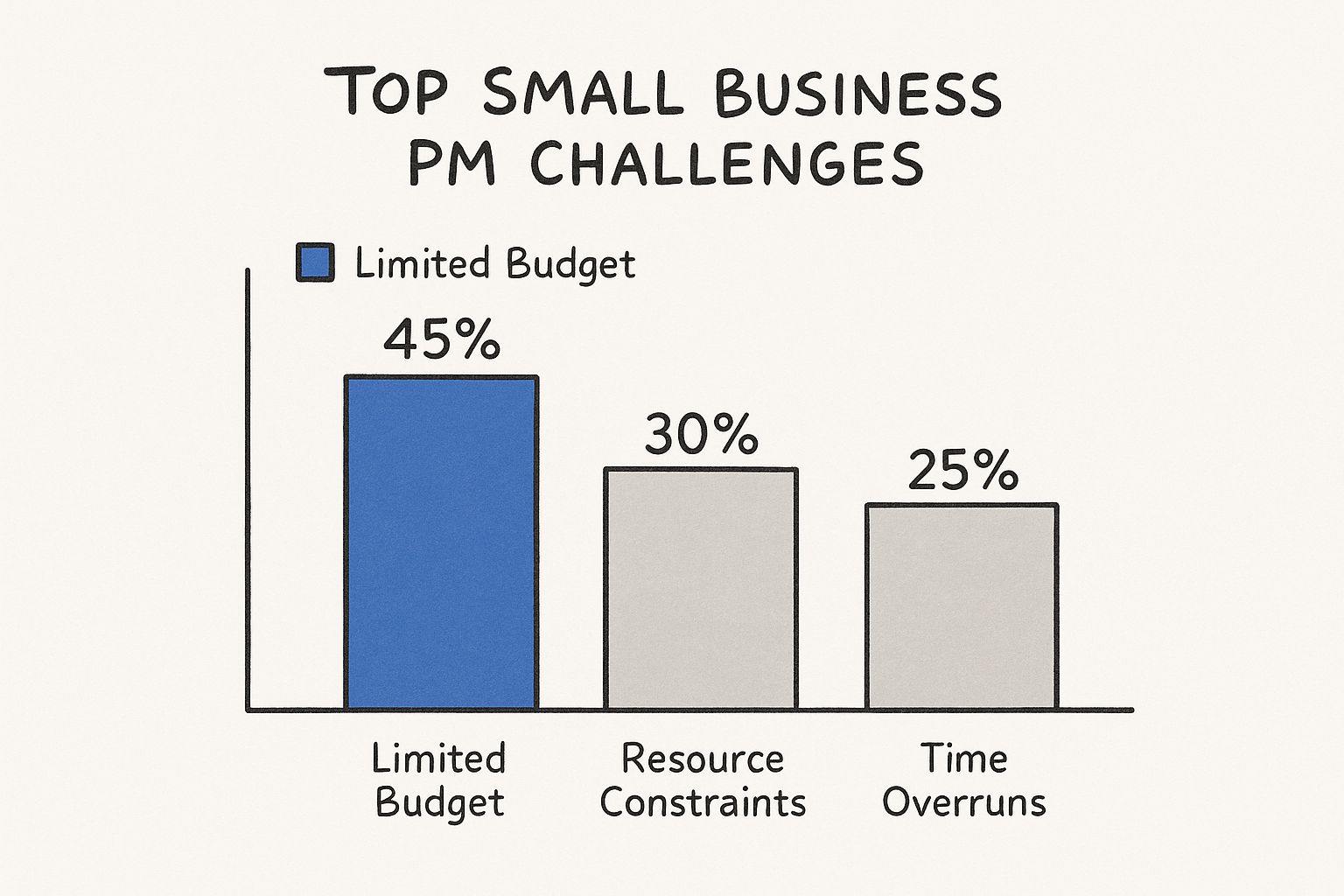
Small Business Project Management Tips for Real Results
Learn effective small business project management strategies to drive success. Discover proven methods to boost your projects today!

Why Small Businesses Win at Project Management

Small businesses often have a built-in advantage in project management. Their smaller size allows for quick decision-making, which is crucial in the ever-changing world of projects. This agility lets them adapt to unexpected changes much easier than larger, more structured organizations. This adaptability leads to higher project completion rates and more overall success. Think of it as steering a small boat versus a massive ship; smaller vessels maneuver tight spaces and change direction faster.
This advantage also applies to team collaboration. Communication in smaller teams is typically more direct and effective. This close-knit setting creates a sense of shared responsibility and accountability, improving team morale and propelling projects forward. For instance, a quick question gets resolved with a short conversation instead of navigating complicated communication channels.
Team members are also more aware of each other's workloads and skills, which helps with efficient task assignments and resource management. This streamlined structure contributes to a more productive project environment.
Maximizing Inherent Advantages
Further solidifying their advantage is the ability to quickly address roadblocks. Small businesses can rapidly implement solutions and adjust strategies without getting stuck in layers of approvals. This responsiveness keeps projects moving forward and helps them take advantage of new opportunities while minimizing the impact of unexpected setbacks.
In fact, small and medium-sized enterprises (SMEs) have a much higher project success rate than larger companies. SMEs boast an impressive 80% success rate, while larger companies are more prone to project failures. This difference highlights the flexibility and adaptability of SMEs, letting them navigate project challenges more effectively. For more detailed statistics, check out this resource: Learn more about Project Management Statistics.
How can small businesses best utilize these inherent advantages? Here are a few key strategies to maximize project success:
- Prioritize open communication: Use tools and practices that encourage clear and consistent communication across the team. Tools like Kanban Tasks from Tooling Studio can significantly improve communication within Google Workspace.
- Embrace flexible methodologies: Tailor project management frameworks like Agile and Scrum to the specific needs of the business and the project.
- Empower team members: Foster proactive problem-solving and decision-making at every level.
- Focus on continuous improvement: Regularly assess project outcomes and pinpoint areas for improvement in workflows and processes.
By leveraging these strengths and implementing these practical strategies, small businesses can consistently outperform larger organizations in project management and achieve sustainable growth. This means delivering projects on time and within budget, fostering a collaborative and innovative culture, and building a strong reputation for reliability and efficiency. This creates a powerful competitive edge in today's dynamic business world.
Essential Project Management Tools That Actually Deliver

The infographic above illustrates the top challenges small businesses encounter in project management. These include budget limitations, resource constraints, and time overruns. The data reveals that 45% of small businesses identify budget limitations as their main concern. Another 30% grapple with resource constraints, while 25% experience time overruns. These difficulties underscore the critical need for efficient project management tools designed to address these specific pain points.
Choosing the right project management software can be pivotal for a small business' success. The right tools can empower teams to maximize their efficiency. However, the sheer number of available options can make the selection process daunting. This section aims to provide clarity on project management solutions that are truly designed for the needs of small businesses.
Key Considerations For Choosing The Right Tool
Selecting project management software requires careful evaluation of several key factors. Small businesses, in particular, should focus on solutions that align with their budget and operational requirements.
Features: Does the software offer essential features like task management, collaboration tools, and reporting? Avoid unnecessary features and prioritize functionality that will be actively used.
Pricing: Free software versions can be a good starting point, but may lack features needed for growth. Carefully evaluate the value of paid options and consider long-term costs as your business expands.
Cloud-Based vs. On-Premise: Cloud-based solutions offer flexibility and accessibility, while on-premise solutions offer more control over data security. Determine which deployment model best suits your specific business needs.
The increasing use of project management tools highlights their importance in optimizing workflows. Small businesses are at the forefront of this trend. In fact, smaller businesses are 13% more likely to adopt project management tools than larger enterprises, according to a report by monday.com. This proactive approach reflects the value small businesses place on using digital tools to improve collaboration and workflow efficiency. For more information on this trend, find more detailed statistics here.
Streamlining Workflows With The Right Software
The right project management software can significantly improve key aspects of your operations:
Improved Team Communication: Centralized platforms enable seamless communication, reducing reliance on email and keeping everyone informed.
Enhanced Project Visibility: Clear dashboards and progress tracking provide an overview of all projects, allowing easy identification of potential obstacles.
Streamlined Operations: Automated workflows and task management features save valuable time, allowing teams to focus on high-impact tasks.
For additional tips, consider reading about how to master your to-do list within Google Workspace. Effective task management within your current workspace can significantly boost individual and team productivity.
From Chaos To Control: Real-World Examples
Consider a small marketing agency struggling to manage multiple client projects. Emails flood inboxes, deadlines are missed, and client satisfaction suffers. Implementing a project management tool can bring order to this chaos. Tasks are clearly assigned, deadlines are tracked, and communication becomes streamlined, resulting in happier clients, increased team productivity, and improved profitability.
Likewise, a small e-commerce business can use project management software to coordinate product launches, manage inventory, and track marketing campaigns. By centralizing all project-related data, the business gains a more comprehensive understanding of its operations, leading to more informed decisions and increased efficiency. Choosing the right tool is crucial for effectively managing the complexities of a small business.
To help you choose the right tool, we've compiled a comparison of popular options:
This table compares some popular project management software options suitable for small businesses:
Small Business Project Management Software Comparison: Comparison of top project management tools based on features, pricing, and suitability for small businesses.
| Software | Best For | Key Features | Price Range | Learning Curve |
|---|---|---|---|---|
| Asana | Collaborative teams | Task management, project timelines, communication tools | Free - $24.99/user/month | Easy |
| Trello | Visual project management | Kanban boards, card-based tasks, simple interface | Free - $17.50/user/month | Easy |
| Monday.com | Customizable workflows | Visual dashboards, automation, integrations | Free - $16/user/month | Medium |
| ClickUp | All-in-one project management | Task management, docs, chat, goals | Free - $19/user/month | Medium |
| Wrike | Enterprise-grade features | Project portfolio management, resource management, advanced reporting | Free - $24.80/user/month | Steep |
This comparison highlights key features and pricing to consider when choosing a project management tool. Remember to choose a solution that aligns with your specific needs and budget.
Strategic Project Portfolio Management for Growth

Strategic project portfolio management (PPM) is often linked to large enterprises. But its core tenets can be incredibly beneficial for small businesses with big growth ambitions. By applying these principles, small businesses can make smarter choices about which projects to pursue, ensuring resources are used wisely.
This targeted approach helps maximize the chances of success and minimizes wasted time and effort.
Aligning Projects with Strategic Objectives
Effective PPM for small businesses starts with aligning projects with overarching business strategies. This means clearly defining objectives and then evaluating potential projects based on how well they contribute to those goals.
For example, if a small business wants to expand its market share, projects that directly support this objective should be prioritized. These could include things like developing new marketing campaigns or expanding into new territories.
For streamlined operations and goal alignment in strategic project portfolio management, consider using robust Workflow Management Software.
Prioritizing High-Value Initiatives
After identifying potential projects, small business leaders need to prioritize them based on their potential value. This means assessing factors like potential return on investment (ROI), market demand, and the probability of success.
By zeroing in on high-value initiatives, small businesses can make the most of their limited resources and achieve the greatest possible impact. This concentrated effort is key for optimal results.
The importance of PPM is also being increasingly recognized within the broader project management industry. Around 80% of project managers consider PPM a critical factor in influencing business outcomes. This growing emphasis on PPM reflects the understanding that aligning projects with business strategies is essential for achieving success. Explore this topic further.
Efficient Resource Allocation
Efficient resource allocation is another vital aspect of PPM for small businesses. This involves both financial resources and human capital.
With limited resources at their disposal, small businesses must carefully consider the skills and experience of their team members. They should assign employees to projects where they can contribute the most. This could involve cross-training or outsourcing particular tasks.
Adapting to Market Changes
Finally, successful project management for small businesses requires adaptability. Market conditions and customer needs can shift quickly. Small businesses need to be ready to adjust their project portfolios accordingly.
This might involve pausing or canceling projects that are no longer aligned with strategic objectives. It could also mean pivoting to new initiatives that offer better potential. This flexibility can give smaller companies a competitive edge against larger, less agile organizations.
By staying up-to-date on industry trends and customer feedback, small businesses can proactively adjust their strategies and remain competitive. This responsiveness is crucial for sustained growth in ever-changing markets.
Building Workflows That Maximize Small Team Output
Small business project management hinges on efficient workflows. These workflows must boost productivity without creating excessive administrative overhead. Striking this balance is crucial for maximizing a small team's output. This section delves into the psychology of productivity within small teams and explores how to structure workflows that leverage their inherent strengths.
Breaking Down Complex Projects
One effective strategy is to decompose complex projects into smaller, more manageable phases. This approach makes projects feel less intimidating and allows for more transparent progress tracking. Think of it like planning a long road trip: you wouldn't simply hop in the car and start driving across the country. You'd divide it into daily destinations, making the overall journey less overwhelming and easier to handle.
This phased approach helps sustain momentum and offers regular opportunities to celebrate small victories, which boosts team morale. These incremental wins foster a sense of accomplishment and keep motivation high throughout the project lifecycle.
Establishing Clear Handoff Procedures
Another vital element is establishing clear handoff procedures between team members. When responsibilities shift, unambiguous communication prevents tasks from slipping through the cracks. For instance, when a designer completes a mockup, a well-documented handoff procedure ensures the developer receives all the necessary assets and context, preventing delays and miscommunication.
These handoff procedures should be meticulously documented and readily accessible to all participants. This clarity guarantees everyone understands their roles and the subsequent steps, preventing project derailment.
Creating Helpful Documentation
Documentation often receives negative attention, but it's indispensable for small business project management. However, it shouldn't generate more work than it saves. The aim is to create documentation that improves the process, not hinders it.
This might involve simple checklists for recurring tasks, templates for common projects, or a shared knowledge base addressing frequently asked questions. You might find value in resources like How to master Kanban for non-technical teams for insights on streamlining project tracking. Effective documentation becomes an invaluable asset, empowering team members to work autonomously and efficiently.
Balancing Structure with Flexibility
Finally, thriving small businesses find the equilibrium between essential structure and adaptability. While well-defined processes are fundamental, small teams also require the autonomy to adapt to change swiftly. This adaptability is often their greatest strength compared to larger organizations.
This entails selecting appropriate project management methodologies. While Agile, Scrum, and Kanban are prevalent, they must be tailored to fit the smaller team dynamic. In these settings, team members often wear multiple hats, so flexibility becomes paramount. This streamlined approach enables small businesses to respond effectively to evolving market conditions and client needs, maintaining a competitive edge.
Resource Allocation That Prevents Team Burnout

One of the biggest challenges for small businesses is preventing team burnout. This often means finding the right balance between ambitious goals and limited resources. Your team is your greatest strength, so protecting their well-being is essential for success. This section explores practical resource allocation strategies to keep your team thriving and productive.
Realistic Capacity Planning
The first step in preventing burnout is accurate capacity planning. This means realistically assessing your team's available time and skills. Avoid overestimating what your team can handle, as this can lead to overwork and missed deadlines.
Instead, use project management tools and techniques to track current workloads. Identify potential bottlenecks before they become major problems. This proactive approach helps create manageable project timelines and prevents your team from feeling overwhelmed.
Identifying Resource Constraints
Identifying resource constraints early on is crucial. This means looking beyond just time and considering budget, tools, and specialized skills. For example, what if a project requires video editing expertise, but nobody on your team has those skills?
You'll need to plan for training, hiring, or outsourcing. Proactively addressing these constraints avoids last-minute scrambles, reduces stress, leads to smoother project execution, and boosts team morale.
Outsourcing vs. In-House Decisions
Deciding when to outsource versus handling tasks in-house is another key aspect of resource allocation. Outsourcing offers access to specialized skills and can alleviate pressure on your core team. However, it requires careful consideration of budget and communication.
A decision matrix can help evaluate these factors. Consider the project type, necessary skills, related costs, and potential impact on timelines. The following table provides a framework for making informed decisions about resource allocation, controlling expenses, and maximizing team effectiveness.
The "Resource Allocation Decision Matrix" below offers a strategic framework to help decide when to manage projects internally or outsource them. It helps you weigh different factors for informed decision-making.
Resource Allocation Decision Matrix
Strategic framework for deciding when to handle projects in-house versus outsourcing
| Project Type | In-House Criteria | Outsourcing Criteria | Cost Considerations | Timeline Impact |
|---|---|---|---|---|
| Website Development | Existing team expertise, Budget constraints | Need for specialized skills (e.g., complex coding), Tight deadlines | Lower internal cost, Higher outsourcing cost | Internal may take longer, Outsourcing potentially faster |
| Content Creation | In-house writers available, Consistent brand voice needed | Specialized content required (e.g., technical writing), High volume content demands | Lower internal cost, Variable outsourcing cost | Internal may take longer, Outsourcing potentially faster |
| Social Media Management | Basic social media skills in-house, Limited budget | Need for advanced social media strategy, High posting frequency | Lower internal cost, Variable outsourcing cost | Internal may require more time, Outsourcing potentially more efficient |
This table illustrates how various factors influence resource allocation choices. Careful consideration of these elements leads to better resource management.
Recognizing Early Warning Signs of Overwhelm
Even with careful planning, it's important to watch for signs of team overwhelm. These can include decreased productivity, increased errors, missed deadlines, and negative changes in team communication.
Also, be mindful of signs of stress and frustration. Addressing these signs early is key. This might involve adjusting timelines, redistributing tasks, or providing additional support. By acting proactively, you prevent burnout and maintain team morale and productivity.
Prioritizing and Managing Expectations
Prioritizing competing demands is another essential element in preventing burnout. Clearly communicate project priorities to both your team and clients.
This transparency sets realistic expectations and reduces the pressure of juggling too many tasks at once. Developing contingency plans for unexpected issues is also important. This prepares your team for potential setbacks and provides a framework for navigating difficulties without undue stress.
By implementing these resource allocation strategies, you protect your team’s well-being and set your business up for success. A healthy, motivated team is a productive team. Their well-being is directly tied to the quality of work and overall project success. For additional strategies on combating burnout, explore proven methods on preventing burnout. This resource offers valuable insights for maintaining a productive and engaged team.
Communication Strategies That Prevent Project Derailment
Effective communication is essential for successful project management, especially in small businesses. When team members juggle multiple responsibilities, clear communication becomes even more crucial. It prevents misunderstandings and keeps projects on track. This section explores practical communication strategies to keep everyone aligned and maintain momentum without excessive meetings.
Establishing the Right Communication Cadence
Finding the right communication balance is vital for small business project management. Too many meetings can decrease productivity, while too few can lead to confusion and mistakes. The key is establishing a clear rhythm for check-ins.
Daily Stand-ups: Short, daily meetings are excellent for discussing progress, roadblocks, and priorities. These quick check-ins ensure everyone stays aligned.
Weekly Team Meetings: Longer meetings are essential for in-depth discussions, problem-solving, and strategic planning. These provide a forum for more comprehensive updates and collaboration.
Project-Specific Check-Ins: Meetings focused on individual projects are helpful for ensuring all involved parties stay informed and coordinated. These targeted discussions delve into project-specific details and challenges.
Choosing the Right Communication Channels
Different types of communication require different channels. Using the appropriate tool enhances efficiency and reduces overload. It's like selecting the correct tool from a toolbox: a hammer for nails, a screwdriver for screws.
Instant Messaging: Slack is ideal for quick questions and updates. This allows for immediate feedback and keeps conversations flowing.
Email: Email is better suited for more formal communication, such as project updates or client correspondence. This ensures a documented record of important information.
Project Management Software: Centralizing project-related information within project management software, such as Tooling Studio's Kanban Tasks, creates a single source of truth. This enhances visibility and streamlines communication within platforms like Google Workspace.
Creating a Single Source of Truth
Maintaining consistent documentation is a key aspect of successful project management. This doesn't necessitate excessive paperwork, but rather the creation of reliable reference resources for everyone.
Project Plans: A comprehensive project plan outlines the scope, objectives, timelines, and deliverables. This provides a roadmap for the entire project.
Meeting Minutes: Recording decisions and action items from meetings ensures accountability and facilitates follow-up. This keeps everyone informed of agreed-upon actions.
Shared Knowledge Base: A central repository for project documentation, FAQs, and best practices keeps information readily accessible. This empowers team members to quickly find the information they need.
Facilitating Focused Meetings
Meetings should be purposeful and efficient. Establishing clear agendas, defining objectives, and maintaining focus are crucial. Small businesses can't afford wasted time in unproductive meetings.
Clear Agendas: Distributing agendas in advance allows participants to prepare and ensures focused discussions. This maximizes meeting productivity.
Time Limits: Setting time limits for each agenda item helps maintain focus and prevents meetings from extending unnecessarily.
Action Items: Clearly outlining action items and assigning ownership ensures that decisions lead to concrete actions and outcomes.
Managing Client Communication
Effective client communication builds trust and is essential for project success. Small businesses must communicate clearly and proactively with clients, providing regular updates and addressing any concerns promptly.
Regular Updates: Consistent progress updates build client confidence and maintain their engagement in the project.
Clear Expectations: Establishing clear expectations from the beginning minimizes misunderstandings and contributes to client satisfaction.
Open Communication Channels: Maintaining open communication channels encourages clients to voice concerns before they become major issues. This proactive approach strengthens the client relationship.
Building a Culture of Transparency
A culture of transparency empowers team members to raise concerns before they escalate into significant problems. This necessitates open communication and a psychologically safe environment for sharing feedback. Effective resource allocation is also key. Consider strategies for preventing burnout to maintain team health and productivity. This proactive approach allows for early problem detection and cultivates a collaborative environment. Implementing these communication strategies helps small businesses improve collaboration, minimize misunderstandings, and keep projects on track.
Measuring What Matters: Small Business Project Success
Successfully managing projects in a small business goes beyond simply delivering on time and within budget. It requires a tailored approach to measuring success, one that aligns with your specific business goals and acknowledges your unique constraints. This means developing Key Performance Indicators (KPIs) that capture both the immediate project outcomes and their longer-term impact.
Defining Meaningful KPIs
Think of KPIs as your project's compass, guiding you towards your desired outcomes. They should reflect what truly matters for your business. For example, if your project aims to improve customer satisfaction, a relevant KPI might be the increase in positive online reviews.
Consider also tracking KPIs related to team performance, such as efficiency gains or skill development. These metrics provide a holistic view of project success, demonstrating how each initiative contributes to overall business growth.
The Power of Project Retrospectives
Project retrospectives, conducted after project completion, are invaluable for continuous improvement. These meetings provide a dedicated space for reflecting on what worked well, what could be improved, and lessons learned.
This honest assessment, documenting both successes and challenges, fosters a culture of learning and growth. For example, a retrospective might reveal that communication bottlenecks hindered progress, informing adjustments to future communication strategies.
Creating a Culture of Continuous Improvement
Building a culture that celebrates achievement while honestly addressing shortcomings is crucial. This involves recognizing and rewarding successes while creating a safe environment for discussing challenges.
Publicly acknowledging a team's efficient problem-solving, for instance, can boost morale and reinforce positive behaviors. Learn more in our article about project tracking metrics.
Practical Frameworks for Evaluation
Implementing effective evaluation frameworks is essential for consistent project success. This involves establishing clear criteria for measuring progress and outcomes.
Quantifiable Metrics: Focus on measurable data like conversion rates or sales figures to track progress against concrete goals.
Qualitative Feedback: Gather feedback from stakeholders, including clients and team members, for a comprehensive understanding of project effectiveness.
Lessons Learned Documentation: Systematically document lessons learned during each project. These records become a valuable resource for future projects.
By applying these frameworks, you establish a consistent and structured approach to measuring what truly matters, leading to data-driven improvements.
Using Data to Refine Your Approach
The data gathered through these evaluations provides valuable insights for refining your project management approach. This iterative process, incorporating feedback and lessons learned, fosters continuous improvement.
This means constantly adapting your methods and strategies to enhance your project management capabilities and drive further growth. Just as a gardener tends to their plants, businesses must continuously refine their project management practices.
You might be interested in: How to master Kanban for non-technical teams to further optimize your workflow. This process builds confidence and positions your business for long-term success.
Ready to take your small business project management to the next level? Tooling Studio provides tools specifically designed to streamline your workflow and enhance team collaboration within Google Workspace. From managing tasks with our Kanban integration to our forthcoming CRM, we offer solutions that grow with your business.